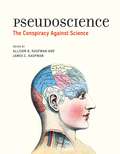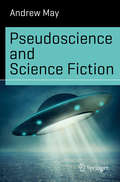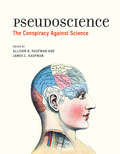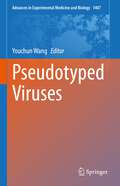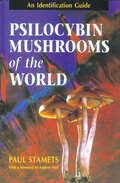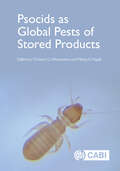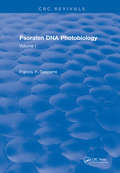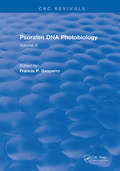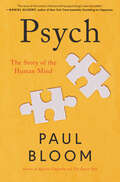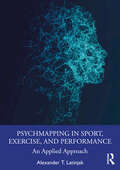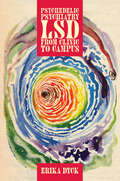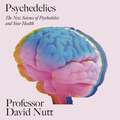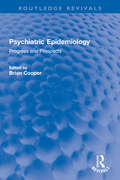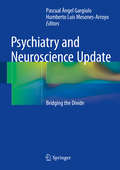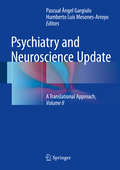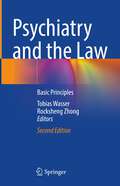- Table View
- List View
Pseudoscience - The Conspiracy Against Science
by James Kaufman Allison Kaufman David Hecht Emilio Lobato Corrine ZimmermanIn a post-truth, fake news world, we are particularly susceptible to the claims of pseudoscience. When emotions and opinions are more widely disseminated than scientific findings, and self-proclaimed experts get their expertise from Google, how can the average person distinguish real science from fake? This book examines pseudoscience from a variety of perspectives, through case studies, analysis, and personal accounts that show how to recognize pseudoscience, why it is so widely accepted, and how to advocate for real science. Contributors examine the basics of pseudoscience, including issues of cognitive bias; the costs of pseudoscience, with accounts of naturopathy and logical fallacies in the anti-vaccination movement; perceptions of scientific soundness; the mainstream presence of “integrative medicine,” hypnosis, and parapsychology; and the use of case studies and new media in science advocacy.
Pseudoscience and Science Fiction
by Andrew MayAliens, flying saucers, ESP, the Bermuda Triangle, antigravity . . . are we talking about science fiction or pseudoscience? Sometimes it is difficult to tell the difference. Both pseudoscience and science fiction (SF) are creative endeavours that have little in common with academic science, beyond the superficial trappings of jargon and subject matter. The most obvious difference between the two is that pseudoscience is presented as fact, not fiction. Yet like SF, and unlike real science, pseudoscience is driven by a desire to please an audience - in this case, people who "want to believe". This has led to significant cross-fertilization between the two disciplines. SF authors often draw on "real" pseudoscientific theories to add verisimilitude to their stories, while on other occasions pseudoscience takes its cue from SF - the symbiotic relationship between ufology and Hollywood being a prime example of this. This engagingly written, well researched and richly illustrated text explores a wide range of intriguing similarities and differences between pseudoscience and the fictional science found in SF. Andrew May has a degree in Natural Sciences from Cambridge University and a PhD in astrophysics from Manchester University. After many years in academia and the private sector, he now works as a freelance writer and scientific consultant. He has written pocket biographies of Newton and Einstein, as well as contributing to a number of popular science books. He has a lifelong interest in science fiction, and has had several articles published in Fortean Times magazine
Pseudoscience: The Conspiracy Against Science (The\mit Press Ser.)
by James C. Kaufman Allison B. KaufmanCase studies, personal accounts, and analysis show how to recognize and combat pseudoscience in a post-truth world.In a post-truth, fake news world, we are particularly susceptible to the claims of pseudoscience. When emotions and opinions are more widely disseminated than scientific findings, and self-proclaimed experts get their expertise from Google, how can the average person distinguish real science from fake? This book examines pseudoscience from a variety of perspectives, through case studies, analysis, and personal accounts that show how to recognize pseudoscience, why it is so widely accepted, and how to advocate for real science. Contributors examine the basics of pseudoscience, including issues of cognitive bias; the costs of pseudoscience, with accounts of naturopathy and logical fallacies in the anti-vaccination movement; perceptions of scientific soundness; the mainstream presence of “integrative medicine,” hypnosis, and parapsychology; and the use of case studies and new media in science advocacy.ContributorsDavid Ball, Paul Joseph Barnett, Jeffrey Beall, Mark Benisz, Fernando Blanco, Ron Dumont, Stacy Ellenberg, Kevin M. Folta, Christopher French, Ashwin Gautam, Dennis M. Gorman, David H. Gorski, David K. Hecht, Britt Marie Hermes, Clyde F. Herreid, Jonathan Howard, Seth C. Kalichman, Leif Edward Ottesen Kennair, Arnold Kozak, Scott O. Lilienfeld, Emilio Lobato, Steven Lynn, Adam Marcus, Helena Matute, Ivan Oransky, Chad Orzel, Dorit Reiss, Ellen Beate Hansen Sandseter, Kavin Senapathy, Dean Keith Simonton, Indre Viskontas, John O. Willis, Corrine Zimmerman
Pseudotyped Viruses (Advances in Experimental Medicine and Biology #1407)
by Youchun WangThis book intends to report the new progress of pseudotyped viruses, including the construction of pseudotyped viruses with different strategies or vectors for most important viruses. Especially for emerging viruses, optimization of the condition and parameters for assay development based on the pseudotyped viruses and widely application as surrogate of authentic virus to study the biological functions of virus, detection of neutralizing antibody, screening viral entry inhibiters, and others. It includes most pseudotyped viruses that have the protein of the target virus on the surface of the parent virus with incomplete genome. The book is likely to be of interest to all researchers in the field of virology, vaccine, and anti-viral drug development and evaluation.
Psicologia e Psiquiatria Antiga para o Mundo Moderno: Ciência Antiga versus Moderna
by Farhad PourgolafshanQuando se trata de antigas ciências médicas, os mal-entendidos e a confusão prevalecem. Diz-se que tudo e qualquer coisa são a cura para isto ou aquilo. Nessa confusão, muitos oportunistas, incluindo alguns médicos, estão obtendo grandes ganhos rapidamente. Em última análise, são os consumidores e os doentes os maiores perdedores nessas circunstâncias. Este livro está a tentar estabelecer alguns pontos de referência para a identificação e avaliação das ciências médicas antigas em geral, e da psicologia e psiquiatria antiga em particular, e os seus tratamentos específicos, a fim de ajudar a minimizar a confusão atual. Há um tratamento detalhado da história das ciências antigas e modernas, pois é necessário para a compreensão da situação atual. Como exemplos, os antigos tratamentos da medicina tradicional chinesa (MTC) para alguns distúrbios psicológicos são fornecidos com alguma profundidade. Há também uma ampla discussão sobre a Teoria da Evolução, o Darwinismo e o Progressivismo como pano de fundo histórico que leva à situação atual.
Psicologia e psichiatria antiche: per il mondo moderno
by Farhad PourgolafshanQuando si parla di scienze mediche antiche prevalgono incomprensioni e confusione. Si afferma che tutto sia una cura di questo o quello. In questa confusione molti opportunisti, i quali includono anche alcuni medici, guadagnano molto e velocemente. Alla fine, sono i consumatori e i malati che pagano le conseguenze di queste circostanze. Questo libro cerca di stabilire dei punti di riferimento per l’identificazione e la valutazione delle scienze mediche antiche in generale e di psicologia e psichiatria antiche e dei loro trattamenti specifici in particolare, in maniera da aiutare a minimizzare la confusione attuale. Il libro contiene un esame dettagliato della storia delle scienze antiche e moderne, come richiesto per comprendere la situazione attuale. Come esempio vengono fornite descrizioni accurate di trattamenti antichi della medicina tradizionale cinese (MTC) di alcuni disturbi psicologici. Viene presentata anche una discussione estesa circa la teoria evoluzionista, il darwinismo e il progressismo, considerati gli eventi storici che hanno contribuito maggiormente ad instaurare la situazione attuale.
Psicología y Psiquiatría Antigua: Para el Mundo Moderno
by Dr Farhad Pour-GolafshanCuando se trata de ciencias médicas antiguas, prevalecen los malentendidos y la confusión. Se afirma que todo y cualquier cosa es la cura para esto o aquello. En medio de esta confusión, muchos oportunistas, incluidos algunos médicos, están logrando grandes ganancias, rápidamente. Por ejemplo, son los consumidores y los enfermos los que más pierden en dichas circunstancias. Este libro intenta establecer algunos puntos de referencia para la identificación y evaluación de las ciencias médicas antiguas en general y para la psicología y la psiquiatría antiguas, en particular. Además, se examinan algunos de sus tratamientos específicos, para ayudar a mitigar la actual confusión. Existe una aproximación específica en la historia de las ciencias, tanto antiguas como modernas, ya que este es necesario para comprender la situación actual. Como ejemplos, podemos citar los tratamientos antiguos de la Medicina Tradicional China (MTC) para algunos trastornos psicológicos los cuales se proporcionan en algunas instituciones, añadiéndose además una extensa discusión sobre la teoría evolucionista, el darwinismo y el progresismo como antecedentes históricos que causaron, aparentemente, la confusa situación en la actualidad.
Psilocybin Mushrooms in Their Natural Habitats: A Guide to the History, Identification, and Use of Psychoactive Fungi
by Paul StametsA full-color guide to psilocybin mushrooms—how to forage, identify, grow, and use them—with detailed descriptions, 300 stunning photographs, tips for dosing safely, and more, from a world-renowned mycologist.The past decade has seen an explosion of interest in using psilocybin (aka psychoactive or &“magic&”) mushrooms for recreational and medicinal purposes.In this comprehensive, full-color reference, Paul Stamets offers descriptions and 300 photographs of more than 60 psilocybin varieties and their lookalikes common to North America, Europe, and Australasia. He outlines the history and cultural use of magic mushrooms in traditional rituals and ceremonies, their natural geographic distribution and habitats, and keys to growing your own mushroom patch. But perhaps most important, Stamets explains how to reliably distinguish between a non-poisonous, psychoactive mushroom and one of its highly toxic, even deadly, lookalikes.Packed with a lifetime of scientific and real-world research, Psilocybin Mushrooms in Their Natural Habitats brings depth and understanding to an often-misunderstood topic. Revealing the potential of these powerful, mind-awakening fungi to help us live better, happier lives through micro- and macro-dosing, this handbook is an indispensable—and potentially lifesaving—addition to mushroom field guides from the biggest name in mycology.
Psilocybin Mushrooms of the World: An Identification Guide
by Paul StametsFrom the author of GROWING GOURMET AND MEDICINAL MUSHROOMS comes the only identification guide exclusively devoted to the world's psilocybin-containing mushrooms. Detailed descriptions and color photographs for over 100 species are provided, as well as an exploration of their long-standing (and often religious) use by ancient peoples and their continued significance to modern-day culture. Some of the species included have just been discovered in the past year or two, and still others have never before been photographed in their natural habitats.
Psocids as Global Pests of Stored Products
by Edited by Christos G. Athanassiou, Manoj K. NayakPsocids have become widespread pests of stored products during the last two decades, yet little was known about their biology and management until this change in their pest status. The aim of this book is to synthesize current information on biology and management of these stored-product insect pests. The book covers their identification, biology and ecology, monitoring, chemical and non-chemical control, resistance to insecticides, molecular biology, and the future of stored-product psocid research. This is the first-ever comprehensive book on Psocids infesting stored products and is written by a carefully selected list of experts on these pests. It is essential reading for all those involved in the control of pests in stored products and postharvest systems, students and researchers in applied entomology and pest management practitioners in general.
Psoralen Dna Photobiology: Volume I
by Francis P. GasparroIn one form or another psoralens have been in use dating back to biblical times for the treatment of depigmented patches of skin. However, it has only been in the past 40 years that the structure and function of psoralens have been elucidated. Although several volumes have been published on photobiology and photomedicine, no one volume has ever been devoted to the psoralen photobiology. In these two volumes we focus on the properties and uses of photoactivated psoralens.In these volumes the various aspects of psoralens are presented in a review of the field as it stands in mid 1986. In retrospect, we may find that this particular time was crucial in the development of new therapeutic modalities as many of the applications of modem molecular biology are beginning to impact on the practice of medicine.This book was written with two purposes in mind. First, to serve as an update (the last collective review of the field was in 1982). Second, it is hoped that newcomers to the fields of photobiology andphotomedicine both scientists and clinicians would find it a useful introduction.
Psoralen Dna Photobiology: Volume II
by Francis P. GasparroIn one form or another psoralens have been in use dating back to biblical times for the treatment of depigmented patches of skin. However, it has only been in the past 40 years that the structure and function of psoralens have been elucidated. Although several volumes have been published on photobiology and photomedicine, no one volume has ever been devoted to the psoralen photobiology. In these two volumes we focus on the properties and uses of photoactivated psoralens.In these volumes the various aspects of psoralens are presented in a review of the field as it stands in mid 1986. In retrospect, we may find that this particular time was crucial in the development of new therapeutic modalities as many of the applications of modem molecular biology are beginning to impact on the practice of medicine.This book was written with two purposes in mind. First, to serve as an update (the last collective review of the field was in 1982). Second, it is hoped that newcomers to the fields of photobiology andphotomedicine both scientists and clinicians would find it a useful introduction.
Psych: The Story of the Human Mind
by Paul BloomA Next Big Idea Club Must-ReadA compelling and accessible new perspective on the modern science of psychology, based on one of Yale’s most popular courses of all timeHow does the brain—a three-pound wrinkly mass—give rise to intelligence and conscious experience? Was Freud right that we are all plagued by forbidden sexual desires? What is the function of emotions such as disgust, gratitude, and shame? Renowned psychologist Paul Bloom answers these questions and many more in Psych, his riveting new book about the science of the mind.Psych is an expert and passionate guide to the most intimate aspects of our nature, serving up the equivalent of a serious university course while being funny, engaging, and full of memorable anecdotes. But Psych is much more than a comprehensive overview of the field of psychology. Bloom reveals what psychology can tell us about the most pressing moral and political issues of our time—including belief in conspiracy theories, the role of genes in explaining human differences, and the nature of prejudice and hatred.Bloom also shows how psychology can give us practical insights into important issues—from the treatment of mental illnesses such as depression and anxiety to the best way to lead happy and fulfilling lives. Psych is an engrossing guide to the most important topic there is: it is the story of us.
PsychMapping in Sport, Exercise, and Performance: An Applied Approach
by Alexander T LatinjakUnderstanding why we act the way we do is key to fostering success. This book introduces PsychMapping, a unique model that visually and philosophically guides readers through the complexities of human behaviour. The holistic approach reveals how different psychological aspects interact and influence each other.The chapters follow the logic of the PsychMapping model, a map of all the key aspects in sport, exercise, and performance psychology. Each chapter is an opportunity for self-reflection and a perfect introduction for anyone interested in exploring the psychological aspects of human behaviour. Packed with practical experiences and real-world case studies, the book applies theories to life, making complex concepts accessible and actionable. A standout feature for professionals is the detailed self-reflection exercise, designed to enhance applied practice.PsychMapping in Sport, Exercise, and Performance is enriching for students, practitioners, and anyone eager to explore the psychological aspects of human behaviour.
Psyche and Matter
by Marie-Louise von FranzTwelve essays by the distinguished analyst Marie-Louise von Franz--five of them appearing in English for the first time--discuss synchronicity, number and time, and contemporary areas of rapprochement between the natural sciences and analytical psychology with regard to the relationship between mind and matter. This last question is among the most crucial today for fields as varied as microphysics, psychosomatic medicine, biology, quantum physics, and depth psychology.
Psychedelic Psychiatry: LSD from Clinic to Campus
by Erika DyckLSD's short but colorful history in North America carries with it the distinct cachet of counterculture and government experimentation. The truth about this mind-altering chemical cocktail is far more complex—and less controversial—than generally believed. Psychedelic Psychiatry is the tale of medical researchers working to understand LSD’s therapeutic properties just as escalating anxieties about drug abuse in modern society laid the groundwork for the end of experimentation at the edge of psychopharmacology. Historian Erika Dyck deftly recasts our understanding of LSD to show it as an experimental substance, a medical treatment, and a tool for exploring psychotic perspectives—as well as a recreational drug. She recounts the inside story of the early days of LSD research in small-town, prairie Canada, when Humphry Osmond and Abram Hoffer claimed incredible advances in treating alcoholism, understanding schizophrenia and other psychoses, and achieving empathy with their patients. In relating the drug’s short, strange trip, Dyck explains how concerns about countercultural trends led to the criminalization of LSD and other so-called psychedelic drugs—concordantly opening the way for an explosion in legal prescription pharmaceuticals—and points to the recent re-emergence of sanctioned psychotropic research among psychiatric practitioners. This challenge to the prevailing wisdom behind drug regulation and addiction therapy provides a historical corrective to our perception of LSD’s medical efficacy.
Psychedelics: The Revolutionary Drugs That Could Change Your Life—A Guide from the Expert
by Professor David NuttThe definitive guide to the science of psychedelics—"the perfect intro for anyone curious about psychedelics and MDMA&” (Ethan Nadelmann, founder and former executive director, Drug Policy Alliance)--and how they can impact our health by world-renowned, leading authority Professor David Nutt. We are on the cusp of a major revolution in psychiatric medicine and neuroscience. After fifty years of prohibition, criminalization and fear, science is finally showing us that psychedelics are not dangerous or harmful. Instead, when used according to tested, safe and ethical guidelines, they are our most powerful newest treatment of mental health conditions, from depression, PTSD, and OCD to disordered eating and even addiction and chronic pain. Professor David Nutt, one of the world's leading Neuropsychopharmacologists, has spent 15 years researching this field and it is his most significant body of work to date. In 2018, he co-founded the first academic psychedelic research center - underpinned by his mission to provide evidence-based information for people everywhere. It revived interest in the understanding and use of this drug in its many forms, including MDMA, ayahuasca, magic mushrooms, LSD and ketamine. The results of this have been nothing short of ground-breaking for the future categorization of drugs, but also for what we now know about brain mechanisms and our consciousness. At a time where there is an enormous amount of noise around the benefits of psychedelics, this book contains the knowledge you need to know about a drug that is about to go mainstream, free from the hot air, direct from the expert. Are you ready to change your mind?
Psychedelics: The revolutionary drugs that could change your life – a guide from the expert
by Professor David NuttThe definitive guide to psychedelics, science and our health by a world-renowned, leading authority, Professor David Nutt.We are on the cusp of a major revolution in psychiatric medicine and neuroscience. After fifty years of prohibition, criminalisation and fear, science is finally showing us that psychedelics are not dangerous or harmful. Instead, when used according to tested, safe and ethical guidelines, they are our most powerful newest treatment of mental health conditions, from depression, PTSD, and OCD to disordered eating and even addiction and chronic pain.Professor David Nutt, one of the world's leading Neuropsychopharmacologists, has spent 15 years researching this field and it is his most significant body of work to date. In 2018, he co-founded the first academic psychedelic research centre - underpinned by his mission to provide evidence-based information for people everywhere. It revived interest in the understanding and use of this drug in its many forms, including MDMA, ayahuasca, magic mushrooms, LSD and ketamine. The results of this have been nothing short of ground-breaking for the future categorisation of drugs, but also for what we now know about brain mechanisms and our consciousness.At a time where there is an enormous amount of noise around the benefits of psychedelics, this book contains the knowledge you need to know about a drug that is about to go mainstream, free from the hot air, direct from the expert.Are you ready to change your mind?(P) 2023 Hodder & Stoughton Limited
Psychedelics: The revolutionary drugs that could change your life – a guide from the expert
by Professor David NuttWe are on the cusp of a major revolution in psychiatric medicine and neuroscience. After fifty years of prohibition, criminalisation and fear, science is finally showing us that psychedelics are not dangerous or harmful. Instead, when used according to tested, safe and ethical guidelines, they are our most powerful newest treatment of mental health conditions, from depression, PTSD, and OCD to disordered eating and even addiction and chronic pain.Professor David Nutt, one of the world's leading Neuropsychopharmacologists, has spent 15 years researching this field and it is his most significant body of work to date. In 2018, he co-founded the first academic psychedelic research centre - underpinned by his mission to provide evidence-based information for people everywhere. It revived interest in the understanding and use of this drug in its many forms, including MDMA, ayahuasca, magic mushrooms, LSD and ketamine. The results of this have been nothing short of ground-breaking for the future categorisation of drugs, but also for what we now know about brain mechanisms and our consciousness.At a time where there is an enormous amount of noise around the benefits of psychedelics, this book contains the knowledge you need to know about a drug that is about to go mainstream, free from the hot air, direct from the expert.Are you ready to change your mind?
Psychiatric Disorders
by Firas H. KobeissyNew high throughput techniques in neuroscience and psychiatry have enhanced the development of experimental, customizable animal models that are predictive of human neuropsychiatric pathology and give vital insights on the mechanisms and pathways involved. In Psychiatric Disorders: Methods and Protocols, key experts have written integrated chapters on neuropsychiatric research sharing their insightful expertise and opinions focusing on both the animal models as well as the cutting edge techniques applied. Beginning with an overview of the animal research in psychiatric illness and substance abuse, this comprehensive volume continues with the modeling of neuropsychiatric illness, drug abuse paradigms and techniques, biomarker identification, autoimmune inflammatory response, and neuroendocrine alteration in the areas of psychiatry, as well as state-of-the-art "Omics approaches" and neurosystems biology/data mining techniques to compute and analyze genomic and proteomics alteration occurring within neuropsychiatric models. As a part of the highly successful Methods in Molecular BiologyTM series, chapters include introductions to their respective topics, lists of the necessary materials and reagents, step-by-step, readily reproducible laboratory protocols, and tips on troubleshooting and avoiding known pitfalls. Thorough and easily applicable, Psychiatric Disorders: Methods and Protocols offers the detailed and clearly illustrated tools necessary for neuroscientists and psychiatrists to handle many unanswered scientific questions with a more creative and insightful approach.
Psychiatric Epidemiology: Progress and Prospects (Routledge Revivals)
by Brian CooperFirst published in 1987, Psychiatric Epidemiology brings together global contemporary research and data relating to psychiatric epidemiology. The book comprises edited papers from the World Psychiatric Association symposium held in Edinburgh, September 1985. Divided into six parts, it covers demographic and ecological surveys; life events, stress and social support; longitudinal and cohort studies; epidemiology and clinical issues; alcoholism and alcohol-related disorders; and epidemiology in mental health service planning. Psychiatric Epidemiology will appeal to those with an interest in the history of psychiatric epidemiology and mental health.
Psychiatric Ethics in Late-Life Patients: Medicolegal and Forensic Aspects at the Interface of Mental Health
by Aarti Gupta Meera Balasubramaniam Rajesh R. TampiThe process of aging is frequently associated with changes in the physical and mental functioning of older adults, challenging their autonomy and rendering them vulnerable to exploitation. Certain illnesses that are more common in older adults can affect their capacity to function independently. These include the capacity to make medical decisions, live independently, manage finances, to name a few. Healthcare professionals, especially psychiatrists are often entrusted with the responsibility of assessing an older adult’s capacity to perform one or more functions. This makes it imperative for them to be cognizant of these issues, understand the need for these evaluations, and be able to conduct them in a comprehensive manner. Another way of protecting an older person’s rights and facilitating a life based on their own decisions even after they lose decision making capacity is Advanced Health Care Planning (AHCP). Health care professionals are required to initiate a discussion about AHCP with their patients and their families and review it periodically. Lastly, the older adults incarcerated in prisons is a group that is growing in numbers. They have unique needs at the intersection of the geriatric and forensic services, but are often marginalized by both services. The combination of poor quality of life and increasing costs makes the care of older adults in the criminal justice system makes this topic an important public health concern. There is a pressing need for better training of prison staff in issues of geriatric psychiatry. Assessment of criminal responsibility and competence to stand trial in aging offenders are other complex but under-studied issues. This proposed book will provide a comprehensive view of ethical, medicolegal, and forensic issues that will be useful in clinical practice. There will be three sub-sections, each focusing on ethical, medicolegal and forensic issues respectively. The first section will focus on ethical issues. Its first chapters will provide an overview of the how age and the process of aging influence decision-making and introduce unique ethical dimensions to clinical care. This will be followed by a discussion of the concepts of informed consent and capacity evaluation. The next chapters will focus on common scenarios that arise in the care of elderly patients and offer a practical approach to understanding and managing them. These will include assessments of the capacity to make medical decisions, the capacity to live independently, manage finances, drive a vehicle, have sexual relations etc. A chapter on ethical issues specific to dementia will outline issues related to diagnostic disclosure and genetic testing. Research ethics issues in geriatric psychiatry will also be outlined. The next section of the book will focus on surrogate decision making in an older adult who has been deemed to lack the capacity to serve one or more functions independently. The first chapters in this sub-section will focus on patient directed advance health care planning tools, namely, living will and power of attorney. This will be followed by an overview of default surrogate making. Guardianship will subsequently be covered. A separate chapter will cover the issue of elder abuse and discuss an approach to assessing it. The last section of the book will cover forensic issues in geriatric psychiatry. The first chapter will discuss aging older adults in the criminal justice system from an epidemiological perspective. The growing numbers of incarcerated older adults, their illness burden, the challenges in the diagnosis and management of neurocognitive disorders in the prison setting will be elucidated. The following chapter will discuss competence to stand trial with reference to elderly offenders. This will be followed by a discussion of the concepts of medical reprieve, compassionate release as well as model programs and policies currently in the works for older incarcerated adults.
Psychiatry and Neuroscience Update
by Pascual Ángel Gargiulo Humberto Luis Mesones ArroyoThe intention of this unique title is to bridge the gap between psychiatry and neuroscience, allowing a fruitful dialogue between both sciences. Recognizing that psychiatry has received important contributions from the basic neurosciences and that the basic neurosciences have received inspiration and objectives from the open problems of psychiatry, Psychiatry and Neuroscience: Bridging the Divide is designed to identify the borders, trends and implications in both fields today. Comprehensive and developed by a renowned group of experts from both fields, the book is divided into four parts: Epistemological Considerations About the Study of Normal and Abnormal Human Behaviors; From Basic Neurosciences to Human Brain; Neurosciences, Learning, Teaching and the Role of Social Environment and Explaining Human Pathological Behaviors: From Brain Disorders to Psychopathology. A unique and invaluable addition to the literature in psychiatry and neuroscience, Psychiatry and Neuroscience: Bridging the Divide offers an important and clearer understanding of the relationship between psychiatry and neuroscience.
Psychiatry and Neuroscience Update - Vol. II
by Pascual Ángel Gargiulo Humberto Luis Mesones-ArroyoThe aim of this unique book is to provide an overview of recent advances bridging the gap between psychiatry and neuroscience, allowing a fruitful dialogue between both sciences. The emerging interactions and mutual contributions between neuroscience and psychiatry are here recognized. This book is designed to identify the borders, trends and implications in both fields today. Comprehensive and developed by a renowned group of experts from both fields, the book is divided into four parts: Epistemological Considerations About the Study of Normal and Abnormal Human Behaviors; From Basic Neurosciences to Human Brain; Neurosciences, Learning, Teaching and the Role of Social Environment; and Explaining Human Pathological Behaviors: From Brain Disorders to Psychopathology. A unique and invaluable addition to the literature in psychiatry and neuroscience, Psychiatry and Neuroscience Update - Vol. II: A Translational Approach offers an important and clearer understanding of the relationship between these two disciplines. This book is directed to students, professionals and researchers of medicine, psychology, psychopedagogy and nursery.
Psychiatry and the Law: Basic Principles
by Tobias Wasser Rocksheng ZhongThis book is designed to help new psychiatrists and other medical professionals confront the complicated legal and ethical issues that arise at the intersection of the mental health and judicial systems. The law provides the boundaries in which clinical care operates. Appreciating these boundaries is particularly important when working with individuals whose rights may already be curtailed (forensic settings, for example). Understanding how psychiatry and the law interface provides students and trainees with a foundation for building their skills and attitudes through training and beyond. This text can guide or supplement education on the legal regulation of psychiatry, the use of psychiatry to answer legal questions, and the treatment of individuals with criminal justice involvement.In the second edition of this text, the editors have updated several chapters with new information and added chapters covering topics not addressed in the first edition. Each chapter begins witha clinical case vignette that brings the topic to life through a clinical encounter, the majority of which are based on landmark legal cases that set a historical precedent. The text presents details of the legal case, historical significance, and the precedent it set before discussing the core principles of the subject area. Each chapter reviews the existing literature and reinforces the most salient points. Topics include risk assessment, substance misuse and the law, legal issues within child and adolescent psychiatry, involuntary medication considerations, and other challenges that are often not sufficiently addressed in training.Psychiatry and the Law: Basic Principles covers a wide range of topics that would be suitable for use as the basis of a course in forensic psychiatry for psychiatry residents and is an excellent resource for new psychiatrists, psychologists, social workers, students, and other professionals navigating medical and legal boundaries in clinicalpractice.
